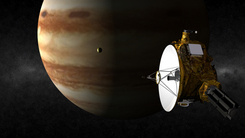
I’m not sure that many folks know about the New Horizons probe, which is in route to the Pluto-Kuiper Belt, in the outer solar system (this is beyond the orbit of planet Neptune).
The New Horizons spacecraft was launched in January of 2006, got a gravity assist with a fly-by of Jupiter early this year (2007), and it is on its way to the outer regions/edge of the solar system, arriving, if all goes well, in the year 2016.
During the fly-by of Jupiter earlier this year, the probe took some gorgeous photos of Jupiter and its moon Io — see Pluto-Bound New Horizons Sees Changes in Jupiter System.
At the time of this writing the mission elapsed time is 639 days, with 2,729 days to go. Note that by then the Constellation program should be in full swing towards the Moon (I can’t wait to see again humans returning to the Moon).
See the gorgeous photo of Jupiter and its moon Io erupting taken by the New Horizons probe:
About the Image: This is a montage of New Horizons images of Jupiter and its volcanic moon Io, taken during the spacecraft’s Jupiter flyby in early 2007. The Jupiter image is an infrared color composite taken by the spacecraft’s near-infrared imaging spectrometer, the Linear Etalon Imaging Spectral Array (LEISA) at 1:40 UT on Feb. 28, 2007. The infrared wavelengths used (red: 1.59 µm, green: 1.94 µm, blue: 1.85 µm) highlight variations in the altitude of the Jovian cloud tops, with blue denoting high-altitude clouds and hazes, and red indicating deeper clouds. The prominent bluish-white oval is the Great Red Spot. The observation was made at a solar phase angle of 75 degrees but has been projected onto a crescent to remove distortion caused by Jupiter’s rotation during the scan. The Io image, taken at 00:25 UT on March 1st 2007, is an approximately true-color composite taken by the panchromatic Long-Range Reconnaissance Imager (LORRI), with color information provided by the 0.5 µm (“blue”) and 0.9 µm (“methane”) channels of the Multispectral Visible Imaging Camera (MVIC). The image shows a major eruption in progress on Io’s night side, at the northern volcano Tvashtar. Incandescent lava glows red beneath a 330-kilometer high volcanic plume, whose uppermost portions are illuminated by sunlight. The plume appears blue due to scattering of light by small particles in the plume. This montage appears on the cover of the Oct. 12, 2007 issue of Science magazine. Credit: NASA/JHU/APL.
ceo
